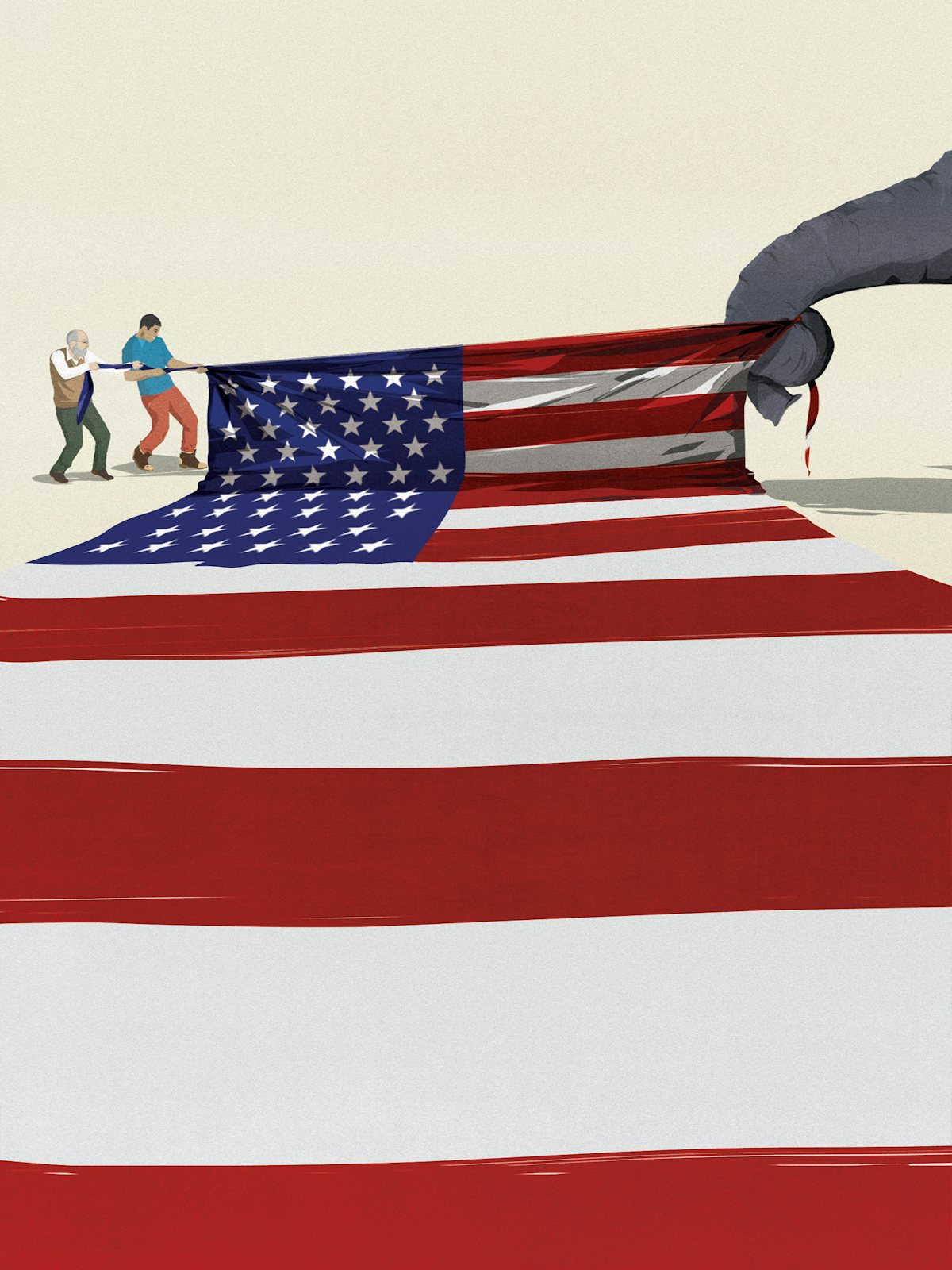Not long ago, a collective of young people issued a manifesto. They began by reflecting on the complacency of their childhood, and on their newfound spirit of protest. The “struggle against racial bigotry,” they wrote, has “compelled most of us from silence to activism.” Their generation, the authors proclaimed, was the last chance to convince the American public that there were alternatives to the debased present, and that something approaching a true democracy might actually be possible.

The manifesto in question comes from 1962: the Port Huron Statement, one of the central documents of the American New Left. It could, though, have come from almost any moment in the past century. The belief in the regenerative qualities of the youth is a warmed-over version of the old belief in inevitable historical progress. Since 1920, at the latest, every generation has had its champions—those who fervently believed that this would, at last, be the group of young people who would bring a chaotic world to order.
Although Millennials like me might prefer to forget it, we were once the chosen ones. I certainly remember popping Nirvana into my Discman and feeling certain that, once kids my age were old enough to wield real influence, the stuffed shirts wouldn’t know what hit them. As late as 2000, a spate of commentators thought that we would emerge as “the next great generation,” righting the ship of state after the tumult of the 1990s. Given our manifest failure, and our own stuffed shirts, another wave of pundits has foisted similar hopes on to Generation Z. In his first public remarks after leaving the presidency, Barack Obama declared that his daughters’ generation had an enlightened outlook, and that the biggest task in our politics was “to get this next generation and to accelerate their move towards leadership.” For Obama, the youth represent toleration and an opportunity to overcome polarization. For more left-leaning thinkers, they represent, instead, a well of pent-up revolutionary energy. The Justice Democrats announce in huge letters on their website that it is time to “elect the next generation.” And at Jacobin, Connor Kilpatrick and Matt Karp have argued that Bernie Sanders’s exceptional polling among young voters portends a rising tide of socialism.
There is good reason to be skeptical. Youthful energy can ricochet in all kinds of directions (Alexandria Ocasio-Cortez is young, but so is Madison Cawthorn). Previous hopes for a messianic wave of youth revolution have been dashed. Insofar as young people have exercised political agency, it has not necessarily been the sort that the left might like. After World War I, fascists capitalized on youthful enthusiasm better than their competitors, and in some European Union countries today, disgruntled youth are increasingly opting for the far right. Meanwhile, the vaunted history of social democracy is not really a story about youth. The postwar welfare regimes in both Europe and the United States, which so often enthrall contemporary observers, were built by older, battle-scarred men.
A politics that relies on young people to revitalize democracy and address inequality is likely to prove a disappointment. Even if younger people began to turn out to the polls at higher rates than they do now, the demographic tides are against them: In the next 10 years, census projections indicate, the number of Americans between 18 and 44 will stay roughly the same, while the 65-plus cohort will swell by about 17 million. This demographic fact, however, does not foretell the shape of our politics. As social researcher Bobby Duffy sets out to show in his new book, The Generation Myth, generations are not as real, or as important, as we think they are. The most pressing issues simply do not map neatly onto generational cleavages. Older people are subject, if in different ways, to the same inequalities as the young—a worsening climate crisis, a lack of affordable care, racial inequity—and have just as great a stake in building a better world. A generational war does not serve the interests of the young, and only an intergenerational alliance can create a world worth getting old in.
How different, really, are the generations? Does it make sense to understand our political future through the lens of generational war? Bobby Duffy asks these questions, and his answers are worth listening to. Duffy is a social scientist who worked as an executive for the market research group Ipsos before assuming his current post at King’s College London. The title of his book is something of a misnomer. Surveying the state of social-scientific research about the differences between the generations, The Generation Myth holds that, though there are real differences, many widely held notions of generational difference don’t match the reality.
There are two major, unmissable differences between Boomers and their successors. The first is economic. Boomers took advantage of a unique confluence of economic factors. Their jobs were more likely to be unionized, and to provide pensions. And yet the more important advantage had nothing to do with wages, which are not after all the source of real wealth. Boomers were able to buy homes and build fortunes through the simple logic of asset appreciation. Younger people have by and large been frozen out of this arrangement, just as wage stagnation has closed other avenues to wealth. The second major difference is educational. My sense coming into the book was that college attendance exploded for Boomers and has since risen slowly. The truth is quite different. There was indeed a jump between Boomers and their parents, but that progress did not plateau. Millennials are much more likely than Boomers, and even than Generation X, to hold bachelor’s degrees.
As a matter of social history, the standard story is basically right: Millennials and Generation Z are better-educated, and more economically precarious, than their predecessors. This could in principle create a new political and social order, in which the woke and the immiserated throw up the ramparts and remake the world in their young image. This, to state the obvious, has not happened.
Why not? Duffy’s main finding is that, economic differences notwithstanding, it is hard to prove robust differences between the generations on cultural and political questions. The familiar figure of the “liberal youth” or the “conservative older person” simply does not match the reality. Many polarizing issues split basically the same in each generational group. About half of Americans, regardless of generation, believe that abortion is wrong, and have for some time. On most other divisive issues, there has been more movement over time, but with few differences between generations: Over the last several decades, there has been a general liberalization of views in all generations about gay marriage, interracial relationships, female employment, and so on. “The overall impression we get,” Duffy writes, “is not of a sudden shift with the latest generation of young people but rather a remarkable change among most generations over the past three or four decades.” Opinion on climate change follows a similar trajectory. Younger people are slightly more concerned with environmental issues than their elders, though this effect is not as large as you would think, and is narrowing over time.
Duffy is unconvinced, therefore, that a coming youth wave will transform Western political systems. The views of younger voters aren’t different enough, and even if they were, there aren’t enough of them, and they don’t vote reliably enough (this is true in many places, and is not simply an American malady). Young people, of course, will get older, and begin to wield more power, but their preferences will likely not remain stable as they do so. Duffy is greatly concerned with what he calls life-cycle effects: those changes that take place as people age, and which many mistake for generational effects. For our purposes, the most important of these is political. There is an enormous amount of debate about the old adage that people become more conservative as they age. In general, Duffy’s book shows that this isn’t so; but when it comes to voting, there is a grain of truth to it. In recent decades, voters have tended to become slightly more conservative as they age, and though the effect is not all that strong, there are so many older people, and they vote so reliably, that it has an outsize political impact.
The mechanism that pulls older voters to the right is not biological. It is a recent historical creation, and one that has much more to do with political economy than it does with aging. Right now, older people hold an inordinate amount of wealth, and vote accordingly (only in the past few decades have older people been a privileged economic group, and only in the past two decades have they become reliably conservative voters). This dynamic will persist beyond the Boomers themselves. Boomers are set to pass their assets on to their Millennial children, and my generation is set to become stunningly wealthy over the next decade, even if that wealth will be unequally spread. There is little reason to believe that Millennials will steward the nation’s wealth any more responsibly than Boomers have. Intergenerational inequality, and its associated voting patterns, is not the result of greedy older people. It is instead the logic of the life course in the asset economy. Generational thinking, insofar as it obscures this fact, keeps us from understanding the true engines of inequality in the United States.
Is there any strategic value to generational thinking? A comparison of generations certainly draws our attention to the (very real) plight of the youth, and it creates a sense of hope that a new revolutionary subject might, at last, be in the offing. Perhaps the point of generational thinking has never been to make empirical claims about the generations, but rather to galvanize a political project around the youth, their supposed values of dynamism and inclusivity, and the future that they represent.
And yet, in the main, generational thinking does more harm than good. One problem is that an emphasis on generations can breed complacency. Duffy, for instance, thinks that older generations are basically democratic, tolerant, and concerned for the climate. He is pleased to find that the younger generations are essentially the same, and therefore that all the anxiety about the collapse of democracy pales in the face of demographic destiny. This seems, to put it lightly, like a misunderstanding of what is happening to democracy in 2021. But more leftist commentary has the same issue. Many pundits seem to think that the stated anti-capitalist views of Generation Z will lead to a socialist renaissance, and that there is little to do but wait. This is a fantasy, as history shows. By some measures, young people in the 1970s were more anti-capitalist than those of today; a decade ago, too, young people were telling pollsters that they preferred socialism to capitalism.
An unshakable faith in the young sidesteps the crucial problem of how to create intergenerational community and solidarity. That, history teaches, is the path to lasting change. The great movements of the past were seldom dominated by the youth. Both the New Deal and the Great Society gave enormous benefits to senior citizens, responding to intergenerational activist movements. The civil rights movement was no exception. Martin Luther King Jr. was in middle age when he marched from Selma. Rosa Parks was born before World War I. Fannie Lou Hamer, one of the most important organizers in the South, was almost 50 when she helped younger students organize Freedom Summer. Nostrums about youth virtue and elder folly make these kinds of ties harder to create.
The second major problem is that generational thinking obscures the vast differences that exist within generations—specifically racial ones. In 2019, Reniqua Allen wrote for this magazine about the “missing black millennial,” pointing out that endless discussions about Millennials were, in essence, about young white people. The social scientists who have done the most to popularize “Millennial” as a category based their analysis on a few hundred high school seniors in wealthy D.C. suburbs. “Generation X” was coined by a novelist concerned about the spiritual fate of yuppies in suburban California. Many stereotypes of the Boomer generation do not apply at all to older Black or Latinx Americans, who largely lacked access to the markets in housing and employment that did so much to shape the life course of affluent whites.
Duffy’s book is a case study of how generational thinking obscures the issue of race. For most of the book, race is simply ignored, and the question of how racial minorities might have a different generational trajectory is not asked. The two (short) passages in the book where he discusses race show this blind spot most clearly. One of them concerns racial attitudes among white people (since, as he puts it, racism “is based on how people see different races”). It also comes up in the section on health, where he discusses the famous “deaths of despair” among middle-aged white Americans. The health of minority communities, in the United States or elsewhere, goes unmentioned.
The Generation Myth explicitly aims to show the analytical limits of generational thinking, and it succeeds. It is just as successful, even if accidentally, at showing its political limitations. By creating phantom political agents called “generations,” we get distracted from the cleavages in American life that genuinely do matter.
The only possible path to power for the left requires an alliance between the young, the middle-aged, and the old. This will require a genuine grappling with age and the life course, and an approach that does not get bogged down in hopeless narratives of generational warfare. Far be it from me to say exactly what this will look like, but it will certainly begin with facts rather than myths.
Here, then, are some facts about older people in this country, who bear little resemblance to the Tucker Carlson–addled gerontocracy of the liberal imagination. They are, in the culture war du jour, significantly less likely than people in their twenties to believe in conspiracy theories about Covid, and significantly more likely to be vaccinated. They are not as well protected from economic precarity as many think. Despite access to Medicare, they struggle to cover medical costs and are sold costly supplemental Medicare Advantage plans. About 9 percent of older Americans live below the poverty line, and by this metric they are doing only slightly better than their middle-aged peers. They are significantly more vulnerable to climate change, and it is overwhelmingly the old who are killed by heat waves and hurricanes.
In the next 10 years, the 65-plus cohort will become less white, and less wealthy. Those who are turning 65 now started their working lives in the mid-1970s. These are not the people who enjoyed the largesse of the postwar golden age. They will have fewer assets than the older cohorts that came before them, and they will have to rely on antiquated systems to keep them out of poverty: SSI (Supplemental Security Income), which helps millions of impoverished older Americans, imposes draconian means testing and has not been updated in decades.
And perhaps the most pressing fact of all, the one that should be written in lightning in all of our hearts, was unveiled by Covid-19. America’s nursing homes, where about 1.4 million older people live, are a human rights crisis. About one in 10 nursing home residents in the United States died of Covid-19. The figures are even more horrifying if we look at nursing home residents who are enrolled in both Medicare and Medicaid: More than half of that community contracted Covid, and more than a quarter died. Some of this had to do with the specific nature of the disease. A great deal, however, resulted from the barbaric living and working conditions in these facilities, which are underfunded and understaffed. Where care is in short supply, older people are often sedated at significant risk to their health and well-being; a recent report from The New York Times found that at least 21 percent of nursing home residents are on antipsychotic drugs, meant for the treatment of schizophrenia.
If the younger generations can cease viewing older people as the primary obstacle to utopia, they can encounter them as they are: a diverse group, some rich and some poor, and facing the same issues as other age groups. All need more affordable housing, access to prescription drugs, and racial equity. Most notably, older Americans are tied to the young above all by a vast economy of care that is threatening to come undone. Care for the elderly in nursing homes is shockingly expensive; the costs of childcare are also out of control. We have a situation, therefore, in which standard care needs at each end of the life span risk throwing families into penury. People of all ages share an interest in creating equitable systems of childcare, health care, and eldercare. It is good for all of us if those systems, which all of us will use at many points, are staffed with good-paying jobs, and available at a reasonable cost.
These alliances will be impossible to create if lazy generational thinking continues to cloud political judgment. It does matter when you are born, obviously—but, as Duffy’s subtitle indicates, it matters “less than you think.” Other fault lines in American life are more important, and more explosive. Racism, sexism, climate change: None of this will be solved by the generational passing of the baton. The myth that it will is an old and only intermittently useful one, rooted in the bizarre assumption that traumatized age cohorts will create a better world. Historically, this has not happened, and there is little reason to believe that this time is any different. If a better future is possible, it’s not up to the young to create it. It is up to all of us.






